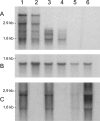Identification of a novel virulence determinant with serum opacification activity in Streptococcus suis
- PMID: 17057090
- PMCID: PMC1695488
- DOI: 10.1128/IAI.00359-06
Identification of a novel virulence determinant with serum opacification activity in Streptococcus suis
Abstract
Streptococcus suis serotype 2 is a porcine and human pathogen with adhesive and invasive properties. In other streptococci, large surface-associated proteins (>100 kDa) of the MSCRAMM family (microbial surface components recognizing adhesive matrix molecules) are key players in interactions with host tissue. In this study, we identified a novel opacity factor of S. suis (OFS) with structural homology to members of the MSCRAMM family. The N-terminal region of OFS is homologous to the respective regions of fibronectin-binding protein A (FnBA) of Streptococcus dysgalactiae and the serum opacity factor (SOF) of Streptococcus pyogenes. Similar to these two proteins, the N-terminal domain of OFS opacified horse serum. Serum opacification activity was detectable in sodium dodecyl sulfate extracts of wild-type S. suis but not in extracts of isogenic ofs knockout mutants. Heterologous expression of OFS in Lactococcus lactis demonstrated that a high level of expression of OFS is sufficient to provide surface-associated serum opacification activity. Furthermore, serum opacification could be inhibited by an antiserum against recombinant OFS. The C-terminal repetitive sequence elements of OFS differed significantly from the respective repeat regions of FnBA and SOF as well as from the consensus sequence of the fibronectin-binding repeats of MSCRAMMs. Accordingly, fibronectin binding was not detectable in recombinant OFS. To investigate the putative function of OFS in the pathogenesis of invasive S. suis diseases, piglets were experimentally infected with an isogenic mutant strain in which the ofs gene had been knocked out by an in-frame deletion. The mutant was severely attenuated in virulence but not in colonization, demonstrating that OFS represents a novel virulence determinant of S. suis.
Figures




References
-
- Allgaier, A., R. Goethe, H. J. Wisselink, H. E. Smith, and P. Valentin-Weigand. 2001. Relatedness of Streptococcus suis isolates of various serotypes and clinical backgrounds as evaluated by macrorestriction analysis and expression of potential virulence traits. J. Clin. Microbiol. 39:445-453. - PMC - PubMed
-
- Arends, J. P., and H. C. Zanen. 1988. Meningitis caused by Streptococcus suis in humans. Rev. Infect. Dis. 10:131-137. - PubMed
-
- Courtney, H. S., D. L. Hasty, Y. Li, H. C. Chiang, J. L. Thacker, and J. B. Dale. 1999. Serum opacity factor is a major fibronectin-binding protein and a virulence determinant of M type 2 Streptococcus pyogenes. Mol. Microbiol. 32:89-98. - PubMed
Publication types
MeSH terms
Substances
Associated data
- Actions
LinkOut - more resources
Full Text Sources
Other Literature Sources
Research Materials

